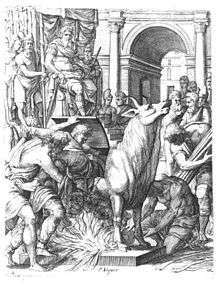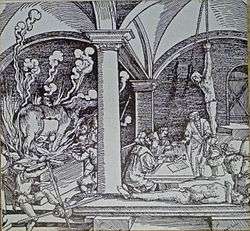Brazen bull
The brazen bull, bronze bull, or Sicilian bull, was allegedly a torture and execution device designed in ancient Greece.[1] According to Diodorus Siculus, recounting the story in Bibliotheca historica, Perillos of Athens invented and proposed it to Phalaris, the tyrant of Akragas, Sicily, as a new means of executing criminals.[2] The bull was said to be made entirely out of bronze, hollow, with a door in one side.[3] According to legends the brazen bull was designed in the form and size of an actual bull and had an acoustic apparatus that converted screams into the sound of a bull. The condemned were locked inside the device, and a fire was set under it, heating the metal until the person inside was roasted to death. Some modern scholars question if the brazen bull ever really existed, attributing reports of the invention to early propaganda.[4]

Creation of the brazen bull for Phalaris

The head of the bull was designed with a system of tubes and stops so that the prisoner's screams were converted into sounds like the bellowing of an infuriated bull. Phalaris is said to have commanded that the bull be designed in such a way that its smoke rose in spicy clouds of incense. According to legend, when the bull was reopened after a body was charred, the victim's scorched bones then "shone like jewels and were made into bracelets."[5]
Stories allege after finishing construction on the execution device, Perillos said to Phalaris: "His screams will come to you through the pipes as the tenderest, most pathetic, most melodious of bellowings." Perillos believed he would receive a reward for his invention. Instead, Phalaris, who was disgusted by these words, ordered its horn sound system to be tested by Perillos himself, tricking him into getting in the bull. When Perillos entered, he was immediately locked in and the fire was set, so that Phalaris could hear the sound of his screams. Before Perillos could die, Phalaris opened the door and took him away. After freeing him from the bull, Phalaris is then said to have taken Perillos to the top of a hill and thrown him off, killing him. Phalaris himself is claimed to have been killed in the brazen bull when he was overthrown by Telemachus, the ancestor of Theron.
Pindar, who lived less than a century afterwards, expressly associates this instrument of torture with the name of the tyrant Phalaris.[6]
Roman persecution of Christians
The Romans were reputed to have used this torture device to kill some Christians, notably Saint Eustace, who, according to Christian tradition, was roasted in a brazen bull with his wife and children by Emperor Hadrian. The same happened to Saint Antipas, Bishop of Pergamon during the persecutions of Emperor Domitian and the first martyr in Asia Minor, who was roasted to death in a brazen bull in 92 CE.[7] The device is claimed to have still been in use two centuries later, when another Christian, Pelagia of Tarsus, is said to have been burned in one in 287 CE by the Emperor Diocletian.
The Catholic Church discounts the story of Saint Eustace's martyrdom as "completely false".[8]

Visigothic kingdom of Toulouse
According to the Chronica caesaraugustana, Burdunellus, a Roman usurper, was roasted in a brazen bull by the king Alaric II in 497.
See also
References
- Notes
- Diehl & Donnelly 2008, p. 37
- Biblioteca Historica, IX, 18-19
- Diehl & Donnelly 2008, p. 39
- Carson, Gary (28 January 2017). "Did The Brazen Bull Actually Exist?". Ancient World Review. Archived from the original on 15 January 2018. Retrieved 3 April 2018.
- Thompson 2008, p. 30
- Pindar, Pythian 1
- The Seat of Satan: Ancient Pergamum
- "Martyrologium Romanum" (Libreria Editrice Vaticana, 2001 ISBN 88-209-7210-7)
- Bibliography
- Diehl, Daniel; Donnelly, Mark P. (2008), The Big Book of Pain: Punishment and Torture Through History, The History Press, ISBN 978-0-7509-4583-7
- Thompson, Irene (2008), The A to Z of Punishment and Torture: From Amputations to Zero Tolerance, Book Guild Publishing, ISBN 978-1-84624-203-8
External links
![]()